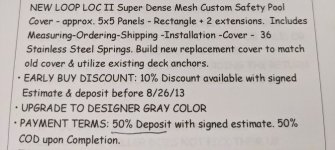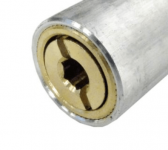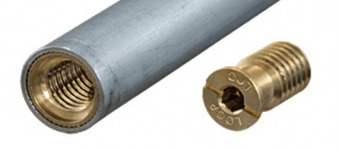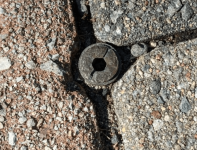That long nut looks home made and pressed into the back of the anchor
Pool cover anchor help
- Thread starter EngineeredPool
- Start date
You are using an out of date browser. It may not display this or other websites correctly.
You should upgrade or use an alternative browser.
You should upgrade or use an alternative browser.
As best as I can tell, they drilled a hole in the bottom of the anchor and then use a bolt/screw to connect it to a coupling nut and then a piece of threaded rod to make the extension.
Seems like a lot of work when they make the correct part.
I would estimate the thread as 3/8” - 16.

 www.mcmaster.com
www.mcmaster.com

 www.mcmaster.com
www.mcmaster.com
Seems like a lot of work when they make the correct part.
I would estimate the thread as 3/8” - 16.
McMaster-Carr
McMaster-Carr is the complete source for your plant with over 595,000 products. 98% of products ordered ship from stock and deliver same or next day.
McMaster-Carr
McMaster-Carr is the complete source for your plant with over 595,000 products. 98% of products ordered ship from stock and deliver same or next day.
- May 23, 2015
- 25,783
- Pool Size
- 16000
- Surface
- Plaster
- Chlorine
- Salt Water Generator
- SWG Type
- Pentair Intellichlor IC-60
Looks like a hack job. Whoever installed it used some kind of threaded screw anchor, possibly for a self-drilling application into concrete, and then just hacked the anchor bolt on top of the hexagonal screw shaft.
Probably best to just replace them with real cover anchors but that will require drilling the proper anchor holes as mentioned above.
As you can see from the corrosion of those screws, those shafts were NOT meant to be buried in moist soil. They are corroding away and would eventually fail. The aluminum tubes used by LOOP LOC will not corrode so easily.
Probably best to just replace them with real cover anchors but that will require drilling the proper anchor holes as mentioned above.
As you can see from the corrosion of those screws, those shafts were NOT meant to be buried in moist soil. They are corroding away and would eventually fail. The aluminum tubes used by LOOP LOC will not corrode so easily.
This is all I could find, installed by a local pool shop but the anchors would have already been there I think.Ok, that's really odd.
Do you know who the cover manufacturer was?
Attachments
To cut a larger hole, make a drill bit guide out of a piece of wood and stand on the wood to keep it secure.
When you guys say drilling.. it's just into dirt, the holes between the pavers already fit the right size (top of the hack jobs are normal anchors). My experience with getting something into dirt (like my garden fence stakes) is hammering not drilling
Also wanted to say again how much I appreciate the information!
Gotcha! Yes my husband says all the holes in the pavers won't need to be drilled larger based on the new anchors but we will have to deal with needing a larger and longer hole in the dirt below the paver. We are at least going to replace the non working ones ASAP and I think plan to replace the rest next season before they fail more. Always something to do for the pool!Looks like you have some extra room, so you might not have to drill a bigger hole if the pipes will fit.
I suspect that you will have to drill some holes bigger, but it is difficult to tell for sure.
View attachment 453844
- May 23, 2015
- 25,783
- Pool Size
- 16000
- Surface
- Plaster
- Chlorine
- Salt Water Generator
- SWG Type
- Pentair Intellichlor IC-60
Once you get everything fixed, you'll want to protect the anchors from corroding as much as possible. You can read this thread on how a TFP user fixed and protected his anchors using end caps -
 www.troublefreepool.com
www.troublefreepool.com
There are many styles of end caps and or plugs that can be used. It would be best to apply a high quality machine grease to the Loop-Loc connectors when the cover is not being used (during the swim season) and to seal up the brass anchors as much as possible. Brass is fine with outdoor exposure and will only darken with a passivating layer that prevents further corrosion. But you want to keep as much junk and dirt out of the anchors as possible. The flexible caps and covers might be an eyesore so you'll have to search Amazon and see if you can find something cheap that will work. Just putting the brass screw back into the anchor and leaving it to sit all swim season is asking for it to get locked up by dirt and debris. Protecting it will help it last a lot longer.
Wall anchor screws getting Rusted
Pool cover was installed end of last year and sheer decent wall has these bolts for pool cover wire anchors. these suppose to be stainless steel but they are getting rusted. i am afraid if i don't fix them now eventually i will have rust drip on wall. i think its the salt water that's rusting...
There are many styles of end caps and or plugs that can be used. It would be best to apply a high quality machine grease to the Loop-Loc connectors when the cover is not being used (during the swim season) and to seal up the brass anchors as much as possible. Brass is fine with outdoor exposure and will only darken with a passivating layer that prevents further corrosion. But you want to keep as much junk and dirt out of the anchors as possible. The flexible caps and covers might be an eyesore so you'll have to search Amazon and see if you can find something cheap that will work. Just putting the brass screw back into the anchor and leaving it to sit all swim season is asking for it to get locked up by dirt and debris. Protecting it will help it last a lot longer.
I really appreciate this advice as wow the amount of dirt in the threads of the ones we were able to actually turn was gross. I would much rather keep up with maintenance than dealing with replacement too soon that's for sure!Once you get everything fixed, you'll want to protect the anchors from corroding as much as possible. You can read this thread on how a TFP user fixed and protected his anchors using end caps -
Wall anchor screws getting Rusted
Pool cover was installed end of last year and sheer decent wall has these bolts for pool cover wire anchors. these suppose to be stainless steel but they are getting rusted. i am afraid if i don't fix them now eventually i will have rust drip on wall. i think its the salt water that's rusting...www.troublefreepool.com
There are many styles of end caps and or plugs that can be used. It would be best to apply a high quality machine grease to the Loop-Loc connectors when the cover is not being used (during the swim season) and to seal up the brass anchors as much as possible. Brass is fine with outdoor exposure and will only darken with a passivating layer that prevents further corrosion. But you want to keep as much junk and dirt out of the anchors as possible. The flexible caps and covers might be an eyesore so you'll have to search Amazon and see if you can find something cheap that will work. Just putting the brass screw back into the anchor and leaving it to sit all swim season is asking for it to get locked up by dirt and debris. Protecting it will help it last a lot longer.
Thread Status
Hello , This thread has been inactive for over 60 days. New postings here are unlikely to be seen or responded to by other members. For better visibility, consider Starting A New Thread.





